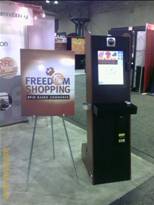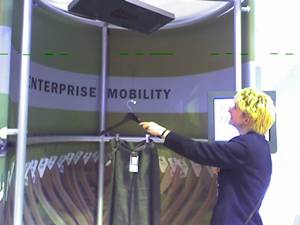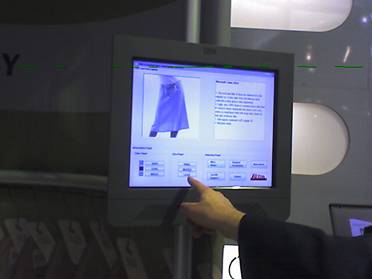I like to browse Vogue or see Fashion File to see the latest trends from the top designers. I don’t want to have the fashion police after me, or wind up on the worst-dressed list. In Retail, if you don’t turn over the styles, you don’t have anything to sell. Right?
So, what is in and what is out of style now? Well, it seems that people are out of style. And unlike platform shoes, they won’t be coming back.
The Human Touch
It is true that retailers do grapple with huge temporary, sometimes inexperienced staff, plus a part-time workforce. So that means they are challenged, since customers want service, have in-depth technical questions, need help finding things, need advice, and for that woman who can no longer fit into her size 4 jeans, some emotional support in that lonely dressing room. A touch only a human can provide.

Or so it goes (or went). Now, your Shopping Buddy is here to help you, or the Personal Sales Assistant (does that mean my assistant? I sure could use one), the Dressing Room Concierge, the Freedom Shopper (something my husband would like me to avoid), the Line Buster (dealing with long checkout lines) and self checkout.
Did you ever notice, though, that the names of all these new personal aid products imply that they are here for me? I know these products of the not-too-distant future (like now) are good economic buys for retailers. They have to work for the retailer. They have to improve productivity, efficiency, reduce shrink, increase sales, and improve throughput, in some measurable way, or I won’t be socially shopping with my buddy. But they also must solve the customers' problems, too, or retailers will never realize those benefits. Customers will reject these innovations, out of hand. These innovations truly have to enhance the customer’s experience.
The Concierge Experience
 Now, people are out, and devices are in. I like the Concierge. I can get into that dressing room and not have to worry; did I get all the pieces together, all the right sizes? Once I am resigned to the fact that I am no longer a size 4, I can tell my Concierge to go get me the size 6, err… maybe an 8, just to be sure.
Now, people are out, and devices are in. I like the Concierge. I can get into that dressing room and not have to worry; did I get all the pieces together, all the right sizes? Once I am resigned to the fact that I am no longer a size 4, I can tell my Concierge to go get me the size 6, err… maybe an 8, just to be sure.
I saw two examples of competing alliance clusters: the Cisco Cluster (leveraging Cisco IP infrastructure), and the other from Attevo, part of the Motorola Cluster (leveraging their in-store wireless solutions). These systems rely on UHF RFID as the item identifier.
So, now that I have my size 6 pants and matching top, it’s on to the checkout. Freedom Shopper is there to settle up. It already has the information about the goods I left the dressing room with (the Concierge dropped a little message off to the Checkout system). However, there were these really cool socks I picked up on the way out. No matter, at about 8 feet away, Freedom Shopper can pick up the socks and add them to my list. So, Ms. Grackin, how do you want to pay? Cash, Credit or Coupon? As it t urns out, I want to use all three. I was given a gift VISA card with $25 by a friend, so I want to use that. I have the 10% off coupon and I will pay the difference with cash. Freedom Shopper can handle all that, and I am then out of the store within a few moments. Plus, I can have my Loyalty points accumulate on my account. Freedom Shopper has Alien Readers embedded, and uses Alien for item tagging.
My cynical self says, wait a minute, do I have to do all this? What about wrapped packages, or people who will help me to my car? I like all that stuff. Yeah, and I liked to get my ticket from the check in counter at the airport, too! You can get through self check-in fast, or you can wait on a line.
On the Line
If you are not comfortable with a self check-out, (I am), the long line can get better with the Line Buster, helping to pre-check-out, get the information about products and the customer, so that when I get up to “paper or plastic," the transaction goes faster.
The Technology works, so how fast will it get adopted? A good question! (See the Inhibitors and Catalysts to Adoption article.)
It is amazing to me how fast the self check-in at the airports took hold. With a modest start and a very few variations in approach, the kinks got worked out, the variance from airline to airline got reduced, and in about 5 years we have an ubiquitous approach.
Now, this is a killer application for the airlines. That is important to understand. They were going to downsize a lot—take it or leave it. So in reducing dependency on people, finding the mundane routines and automating them, was the key. I am not completely sure of that element in the use cases I saw, but I liked the fun aspect. And I do know that in many stores, such as pharmacies, the PSA is critical, since you have so many decisions to make, from the right shampoo (over 30 variants from thin to thick hair, dry, coloured) to cold medicines (also over 20 variants), to tooth paste, etc. No sales person is going to go through the aisles with you for such low-ticket items. But, sadly, neither are they going to go through the aisles with you in many of the high-ticket retail stores such as Bloomingdale's. (Now, at Nordstrom, that’s a different story!)

Self-service is not a new concept. It may not be a welcomed concept, either. But until people are back in style, in many industries, more applications of self-service will inevitably be tried and many will take hold.
We will discuss more of these issues in our upcoming report:
RFID for the Customer Experience.
















